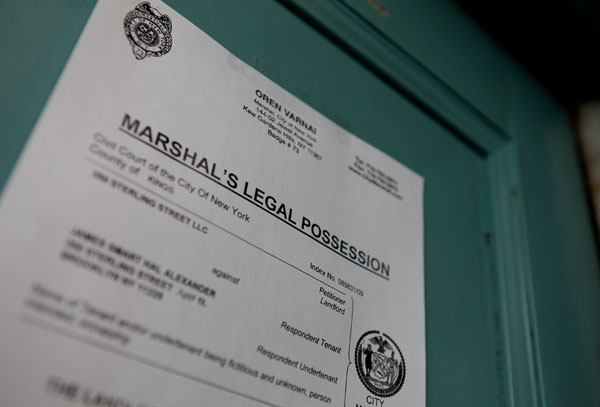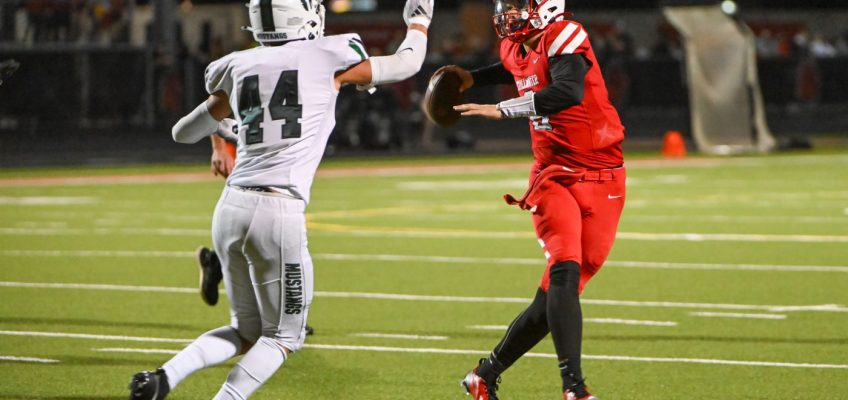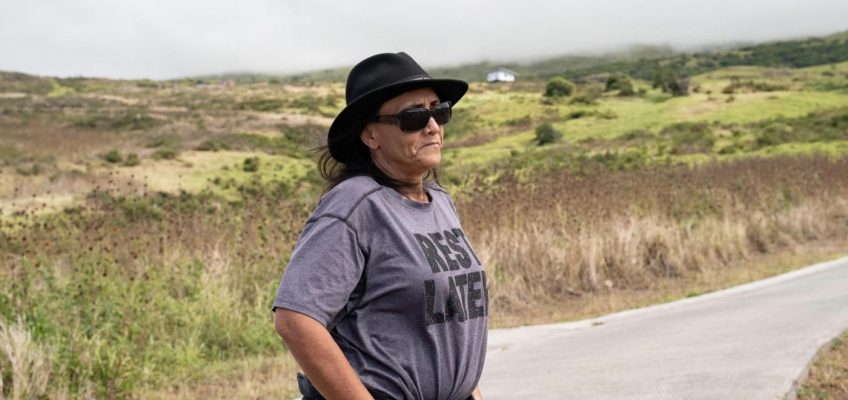The enforcement comes after a City Limits investigation found some marshals were not posting notices of eviction online, as a 2024 state law requires—or were posting them just days before tenants could be removed from their homes.
A marshal’s eviction notice, seen in 2010. Photo by Marc Fader for City Limits.
The Department of Investigation (DOI) will enforce a state law that requires city marshals to post notices of eviction online in addition to serving tenants in person, according to a memo from DOI Commissioner Jocelyn Strauber. The memo, released in late February, says marshals must post notices online within 24 hours of serving them in person, and threatens discipline for noncompliance.
The enforcement comes after a November City Limits investigation found that some marshals were not posting notices of eviction online, or posting them just days before tenants could be removed from their homes. Posting online was required by a state law that took effect at the end of June 2024, but official guidance for marshals wasn’t released until Feb 27, 2025.
“Last year we passed legislation requiring the New York City Marshals to file a notice of eviction by both physical posting and electronic filing to ensure that tenants and their lawyers clearly understood when eviction proceedings were occurring and the timeline for legal response. Unfortunately, as City Limits found in their reporting, there has been inconsistent compliance with this law.” said New York State Senator Brad Hoylman-Sigal.
New York City’s marshals serve eviction notices and carry out evictions in the city in addition to other responsibilities, like booting cars and collecting debts from civil court proceedings. Marshals carried out 16,813 evictions last year and 3,919 so far this year, on track for the most since the end of a pandemic-era moratorium on evictions in the state.
The DOI’s Marshals Bureau oversees city marshals, with the ability to investigate and discipline those who don’t follow state law and the handbook that regulates their actions. Marshals were already required to serve eviction notices in person and by mail prior to the 2024 law mandating the online postings.
When a tenant is served a notice, a 14-day waiting period kicks in, after which they can be evicted at any time.
The increased transparency online posting affords was welcomed by housing advocates like Craig Hughes, who said the rules will help tenants clarify the first possible eviction date. This gives them time to apply for city assistance, transition to new housing, or get reasonable accommodations before entering the shelter system.
Michael Woloz, a spokesperson for the Marshals Association of New York City, a professional group for marshals that also lobbies on their behalf in Albany, told City Limits, “We were not consulted [on the original legislation]. However, we would be eager to work with our lawmakers on any future legislation.”
The original law did not specify when exactly online notice had to be served. City Limits found that out of a sample of 537 eviction notices served in September 2024, 29 were posted online after 14 days—the minimum window before an eviction can be executed—while 37 were never posted at all.
Lawyers for tenants said that failures to post online denied tenants their due process rights and crucial time they could use to prepare a legal defense. Marshals said that they were not consulted on the new rules and needed time to update data systems and procedures in order to comply.
In response, DOI convened stakeholders to make new rules and amended the Marshals Handbook. “We sought to ensure both prompt notice to tenants and that the time-frames imposed were reasonable and realistic,” Spokesperson Diane Struzzi told City Limits.
DOI worked with the state court system, city marshals, and the Legal Aid Society to craft the new guidance, a process the agency said took eight months.
“After a notice of eviction has been served upon a tenant, marshals must file such notice electronically in the New York State Court Electronic Filing (NYSCEF) system,” wrote DOI commissioner Jocelyn Strauber in the Feb. 27 memo outlining the rules. “Absent extraordinary circumstances, this electronic filing shall be completed no later than twenty-four hours following service of a notice of eviction.”
The Marshals Association’s Woloz quibbled with that guidance slightly: “We believe that ‘next business day’ would be appropriate.”
Hoylman-Sigal has already introduced an amendment to the 2024 law that would enshrine the new rules. “I’m pleased that DOI has already updated the Marshall Handbook to include this requirement. My legislation (S.3043) will make that requirement permanent and give a strong legal foundation to DOI’s interpretation of the law,” Hoylman-Sigal told City Limits.
Payton Fisher, a lawyer with Mobilization for Justice, echoed the importance of a legislative remedy, since the current legislation expires in 2026: “the statue has a use-it-or-lose-it quality because of the sunset provision. I think it has a better chance of remaining on the books if we can show that it has been effective.”
The memo also lays out potential disciplinary action for marshals who don’t comply. “Disciplinary action[s] taken against marshals are made on a case-by-case basis and turn on the specific circumstances of each case,” said DOI’s Struzzi. The agency disciplined 11 marshals for errors during evictions from 2019 through mid-2024, as City Limits reported last year.
The rules also strengthen requirements for in-person service for congruence with last year’s law. Marshals are required to attempt in-person service but can leave the notice with an adult resident or post it on the door, and follow up by certified mail. “DOI advises marshals that whenever possible, notices of eviction shall be physically posted on the door of the subject residence, even in circumstances when personal service has been achieved,” wrote Strauber.
But the law won’t fix all the hitches of the eviction system, according to Hughes, a social worker with Bronx Legal Services. Lawyers, tenants, and advocates still rely on marshal’s offices to figure out when an eviction is actually scheduled after the 14-day minimum waiting period is up. And there isn’t consistency in how marshals respond.
Some offices, like Marshal Robert Renzulli’s, have apparently attempted to simplify the process, providing a form response to inquiries about eviction dates that includes the following: “Parties should make decisions in anticipation that execution of the Warrant of Eviction will occur on that ‘Earliest Eviction Date.’”
The move may help reduce how often lawyers and advocates need to call marshal’s offices to find the earliest eviction date, and help marshal’s office staff triage inquiries. But some marshals aren’t able to execute evictions near the first possible date. Sometimes, they’re pushed back or moved up—cases where knowing exactly when an eviction is happening, not just the first possible date, could prove crucial.
In a city that is churning out 40 evictions a day so far in 2025, some advocates say there’s still more to be done to give tenants every chance.
“People should be able to know what to expect when an eviction notice is issued and discretion that allows a marshal to withhold critical information is not helpful discretion,” said Hughes. “We’re talking about making people homeless here. Given that that is the stakes of it, it doesn’t seem at all inappropriate to demand that there is 100 percent transparency.”
To reach the editor, contact Jeanmarie@citylimits.org
Want to republish this story? Find City Limits’ reprint policy here.
The post City Marshals Must Post Eviction Notices Online Within 24 Hours, New Rules Say appeared first on City Limits.




